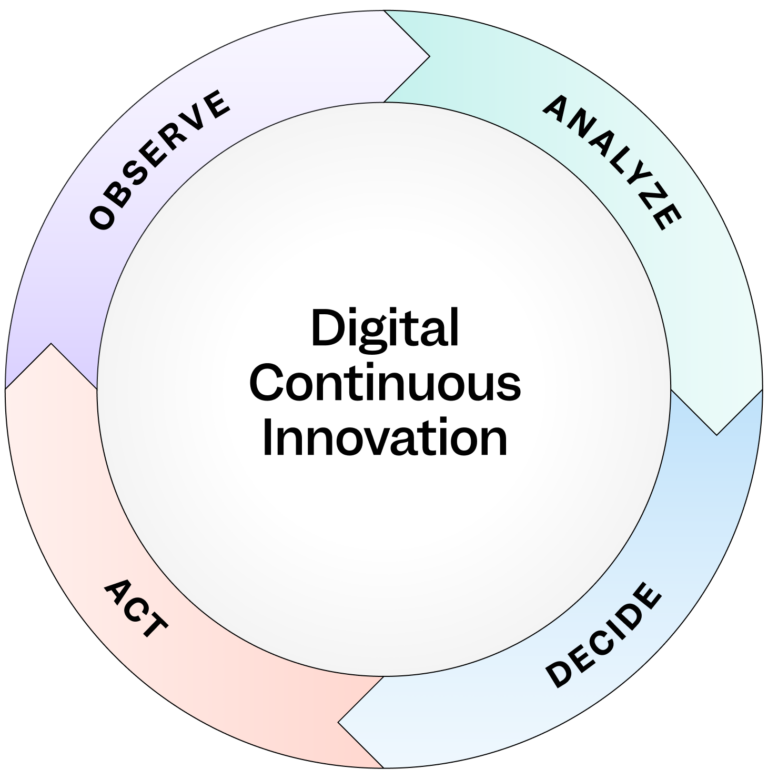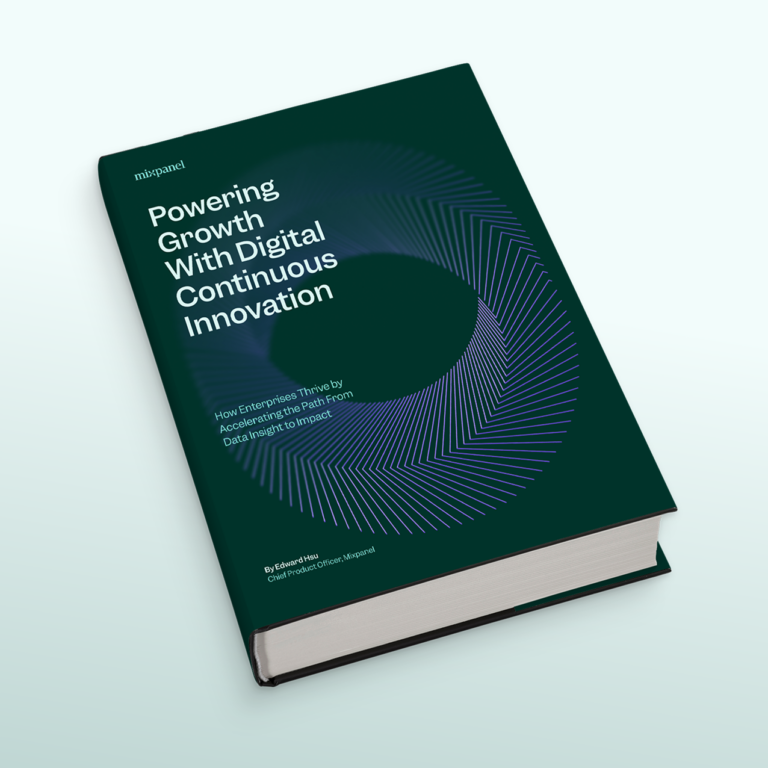
How product teams master the OADA loop to build what matters most

The OADA loop is a process that powers digital continuous innovation (DCI). OADA is made up of four fundamental steps: Observe, Analyze, Decide, Act.
When executed well, these steps occur transparently, quickly, and repeatedly (in a “loop”), helping teams innovate more effectively and with better results.
Moving quickly is a competitive advantage for companies of all sizes, and especially enterprises. The faster organizations can make decisions with confidence, the faster they can iterate and improve their product and their processes, the faster they can deliver value for their customers.
Digital continuous innovation (DCI), is one of the most effective ways for teams to respond to evolving user needs and deliver user-driven innovation. DCI streamlines collaboration, breaks down silos, and makes teams more efficient.
To power digital continuous innovation, organizations use what we call the OADA loop. Here’s a primer on what the OADA loop is, how to use it, and a few examples of OADA in action.
What’s the OADA loop?
Digital continuous innovation requires an ongoing cycle of discovery, alignment, and improvement to ensure you’re always building what truly delivers value to your users. That cycle is the OADA loop.
OADA is made up of four fundamental steps: Observe, Analyze, Decide, Act. What’s important about digital continuous innovation is not that the OADA steps occur, but the fact that they occur transparently, quickly, and repeatedly (in a “loop”).

Observe
The first step is to get a comprehensive understanding of what’s happening. To do that, gather data from systems, users, and processes. This includes quantitative metrics (e.g., usage, conversion, performance, churn) and qualitative signals (e.g., user feedback, session replays).
The goal at this stage is not to diagnose a problem or start to make changes (at least not yet); it’s simply to collect all of the available data to ensure that when the time comes, you’re making confident, data-driven, informed decisions. Tools like Signal help you find user behaviors that correlate to specific outcomes, like higher retention and engagement.
Analyze
Interpret the data you’ve gathered to uncover patterns, issues, or opportunities. There are a variety of tools and techniques that can help you accomplish this, including funnel analysis, user segmentation, root cause investigation, and cohort analysis.
At this stage, you want to use the data you’ve gathered to come up with ideas and hypotheses to test.
Decide
Your analysis will likely surface some potential areas of improvement. But not all actions have the same potential impact. Teams determine what improvements to make based on criteria like business impact, feasibility, and urgency.
At this point in the loop, your aim is to identify potential levers to pull, evaluate how those levers affect your North Star metric, and use that information to prioritize and determine an experimentation plan.
Act
Implement the change—whether that’s a UI tweak, configuration update, or product feature rollout—and monitor results. The outcome becomes the “observe” input for the next iteration.
This step is for running experiments to validate or discard hypotheses. Once you have useful results, you can apply experimental findings and roll out the best-performing variant to all users.
For more details on the OADA loop and digital continuous innovation, download the ebook here.
Creating the conditions for success
To implement the OADA loop for successful digital continuous innovation, you need to create the right conditions for your people, processes, and tools to succeed.
People
Succeeding with DCI requires that your teams be data literate and understand concepts like user experience, data analysis, and experimentation methodologies. Owners must understand user behavior, interpret data insights, and design and analyze experiments effectively. Teams should also be aligned around clear, user-centric objectives and key results (OKRs).
Processes
Continuous experimentation must be baked into your organization’s DNA at every stage of development. That means that teams are empowered and expected to run experiments and proactively identify ideas for improvement. This allows them to rapidly implement small, potentially high-impact changes without getting bogged down in red tape.
Tools
Your tech stack is the foundation of your DCI efforts. Analytics tools should be connected, easy to use for employees outside of the data team, and must facilitate shared alignment across teams. The best tools will combine deep data insights with autonomy. This autonomy streamlines the “act” phase of the innovation cycle, translating data-driven insights into tangible product enhancements with speed and efficiency.
Key steps to take with the OADA loop
Before practicing digital continuous innovation, there are a few steps you can take to help your organization be successful:
1. Assess your current state
Evaluate your organization’s existing data infrastructure, analytical capabilities, team structures, and current improvement processes. Identify the gaps and potential problem areas, and work with your teams to find solutions.
How Mixpanel can help
Mixpanel Warehouse Connectors with Mirror Mode allows you to connect and sync all of your data into a single interface, giving you a centralized, up-to-date view of revenue, CRM, and ad spend data in one place.
2. Cultivate a data-driven culture
Encourage all teams to prioritize data in decision-making. Invest in upskilling your people in UX principles, data literacy, and experimentation methodologies. Encourage cross-functional
collaboration and establish clear, user-centric goals.
How Mixpanel can help
Mixpanel’s intuitive, self-serve user interface makes data accessible to everyone, whatever their technical background. Using a single platform to centralize data promotes collaboration and helps break down silos across teams.
3. Optimize processes
Implement agile methodologies and establish clear ownership for each stage of the OADA loop, empowering owners whenever possible. Streamline workflows to accelerate results, prioritize iterative improvements, and capture small, high-impact wins.
How Mixpanel can help
Mixpanel helps speed up decision-making and makes iterative development and collaboration possible. Features like Roles & Permissions help delineate project ownership and responsibilities.
“With Mixpanel, obtaining necessary data is as easy and quick as pressing a button on a vending machine. This tool significantly accelerates the speed of planning, decision-making, and agile processes.”
Product Manager, T Map Mobility
Read the full case study.
4. Leverage technology strategically
Evaluate your current suite of digital analytics and experience tools. Ensure you have an easy-to-use and integrated platform that makes the tools “disappear” so individuals can focus on the tasks at hand: “observe, analyze, decide, act.”
How Mixpanel can help
Mixpanel integrates seamlessly with your tech stack, including BI tools, data warehouse, advertising platforms, CRMs, and more, so that you can view all of your data in one place.
Example: Using the OADA loop in practice
Rakuten Viber’s 15% messaging lift
Rakuten Viber is a messaging platform that provides secure chat, voice, and video calls, large group communities, and business messaging tools.
Viber used the OADA loop to optimize its in-app keyboard interface. The team analyzed user interaction patterns and realized users prefer visible features over hidden ones. Through iterative A/B testing, a new keyboard was designed that presented users with the most relevant and accessible chat options, which led to a 15% increase in overall messaging.
“Viber needed a tool for product managers to make quick and smart decisions. With Mixpanel, we get the answers we need to execute on our vision. It helps us all answer questions quickly so we understand user behavior and identify trends, empowering us all to make more informed decisions and simply move so much faster.”
Oz Radiano, Senior Product Manager, Rakuten Viber
Read the full case study.
Mixpanel and the OADA loop: A SaaS company optimizing trial-to-paid conversion
Mixpanel powers every step of the OADA loop. Here’s an example of what that can look like for a SaaS company that wants to optimize trial-to-paid conversions:
- Observe: Mixpanel dashboards show 23% trial-to-paid conversion, down from 28%.
- Analyze: Funnel analysis reveals a 40% drop-off at feature setup.
- Decide: Using this information, the team decides to prioritize simplified onboarding by streamlining the signup process and adding clearer instructions.
- Act: A/B test new setup flow, measure with Mixpanel Experiments. Use the insights gained to spark the next round of experimentation.
Start powering your growth with the OADA loop
Creating a culture of digital continuous innovations requires an ongoing commitment to people, processes, and technologies. But the payoff is worth it: Implementing the OADA loop helps organizations thrive and positions them to take broader advantage of AI-enabled automation in the future.

Download the full DCI ebook to learn more, or book a personalized Mixpanel demo and see how we can enable the OADA loop for your teams.


